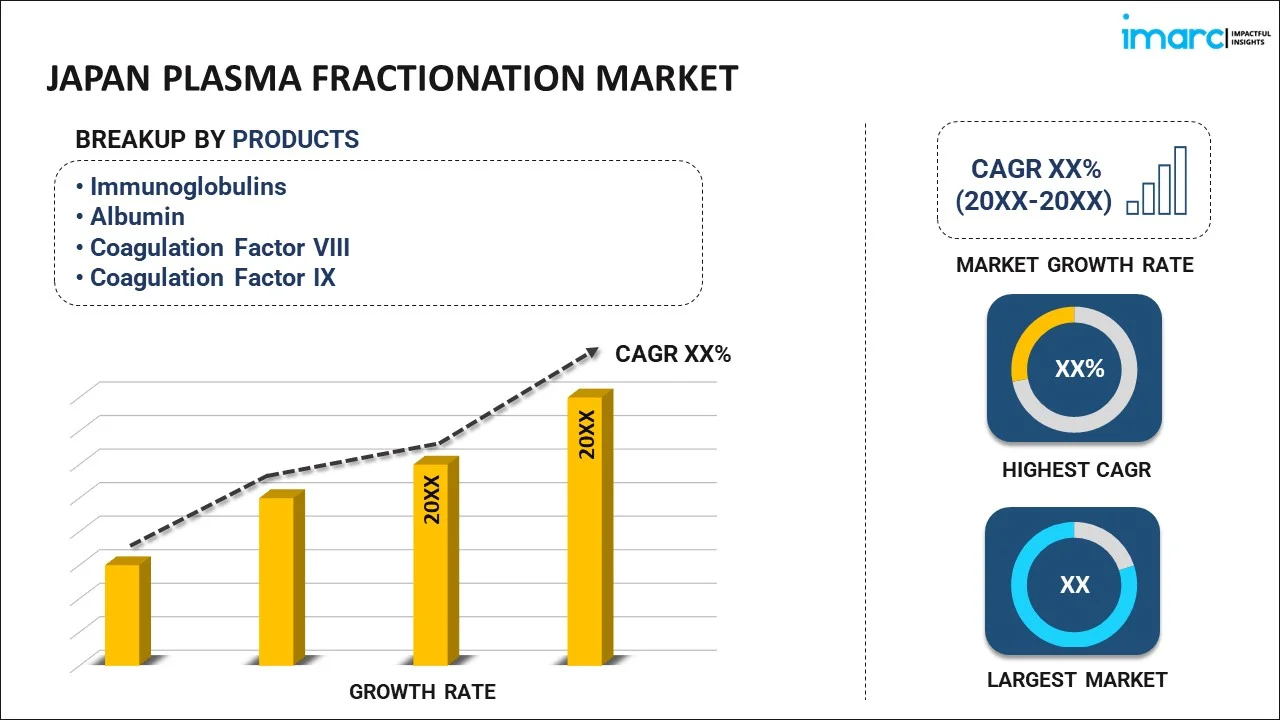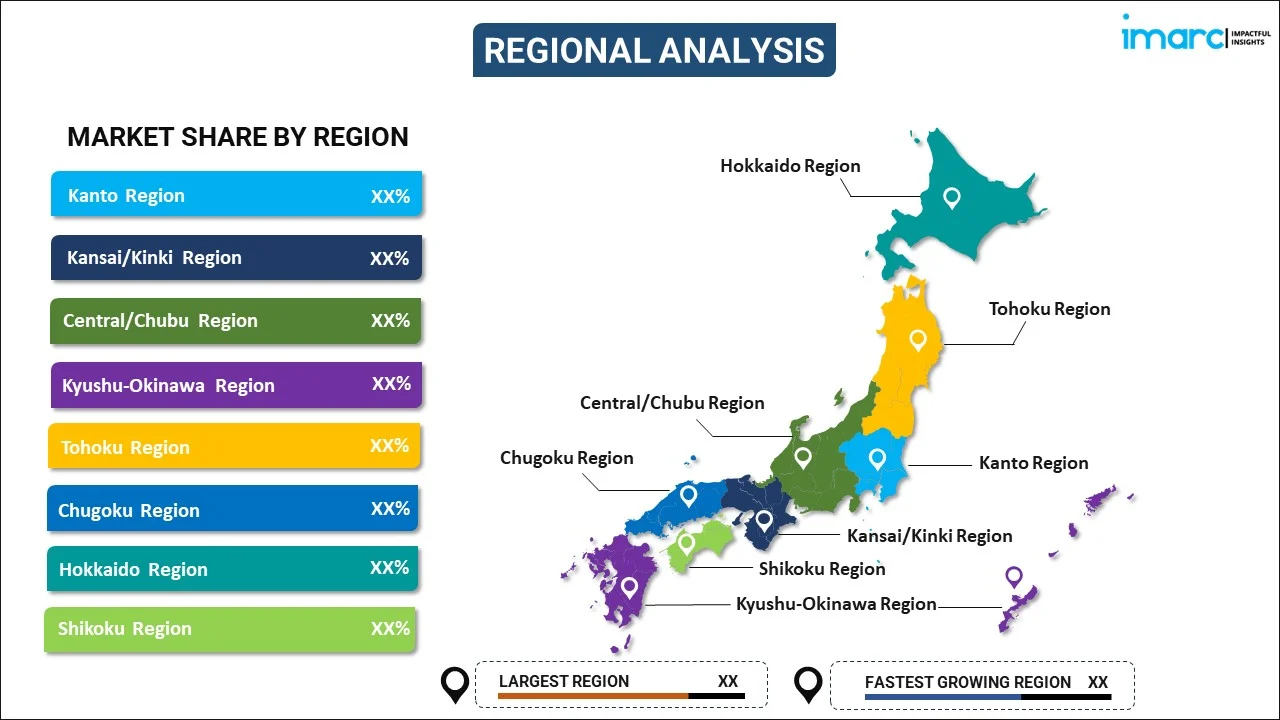
Japan Plasma Fractionation Market Report by Product (Immunoglobulins, Albumin, Coagulation Factor VIII, Coagulation Factor IX), Sector (Private Sector, Public Sector), Application (Neurology, Immunology, Hematology, and Others), End User (Hospitals and Clinics, Clinical Research Laboratories, Academic Institutes), and Region 2025-2033
Market Overview:
Japan plasma fractionation market size reached USD 902.9 Million in 2024. Looking forward, IMARC Group expects the market to reach USD 1,702.3 Million by 2033, exhibiting a growth rate (CAGR) of 6.7% during 2025-2033. The rising focus among government bodies to introduce cost-effective viral inactivation technologies to safely utilize local plasma resources is primarily driving the market growth.
|
Report Attribute
|
Key Statistics
|
|---|---|
|
Base Year
|
2024
|
|
Forecast Years
|
2025-2033
|
|
Historical Years
|
2019-2024
|
| Market Size in 2024 | USD 902.9 Million |
| Market Forecast in 2033 | USD 1,702.3 Million |
| Market Growth Rate (2025-2033) | 6.7% |
Plasma fractionation is the process of converting donated plasma into crucial life-saving treatments and medical products. It involves the division of plasma into individual proteins or plasma fractions through mechanical separation techniques like centrifugation, depth filtration, precipitation, and chromatography. In contemporary fractionation processes, various methods including alcohol concentrations, time, temperature, and pH adjustments are employed to isolate particular therapeutic proteins. Furthermore, the advancement of technology complexity over time and the implementation of viral reduction treatments during the manufacturing process have led to the emergence of novel protein therapies and enhancements in the purity and quality of products.
Japan Plasma Fractionation Market Trends:
Protein products derived from human plasma constitute a vital category of therapies extensively employed for the prevention, management, and treatment of life-threatening conditions, encompassing infections, congenital deficiencies, rare blood disorders, immunologic ailments, and autoimmune disorders. A significant upsurge in the prevalence of these conditions within a substantial portion of the population serves as a primary driver underpinning market expansion. Furthermore, manufacturers are incorporating added safety features into plasma fractionation procedures in response to stringent regulations and quality control measures mandated by regulatory agencies in numerous countries, which is positively influencing the regional market. Additionally, market stakeholders are directing financial resources towards research and development (R&D) initiatives aimed at advancing plasma production technology, thereby acting as significant growth-inducing factors. These endeavors aim to enhance product effectiveness and boost the recovery of immunoglobulin G (IgG) for the isolation of novel plasma proteins. Furthermore, they are focusing on developing cost-effective viral inactivation and processing technologies that enable the safe utilization of local plasma resources. This, in combination with the growing imperative to optimize yield, maintain process cost-efficiency, and comply with increasingly stringent regulatory standards, is poised to create a favorable market outlook in the forthcoming years.
Japan Plasma Fractionation Market Segmentation:
IMARC Group provides an analysis of the key trends in each segment of the market, along with forecasts at the country level for 2025-2033. Our report has categorized the market based on product, sector, application, and end user.
Product Insights:

- Immunoglobulins
- Albumin
- Coagulation Factor VIII
- Coagulation Factor IX
The report has provided a detailed breakup and analysis of the market based on the product. This includes Immunoglobulins, albumin, coagulation factor VIII, and coagulation factor IX.
Sector Insights:
- Private Sector
- Public Sector
A detailed breakup and analysis of the market based on the sector have also been provided in the report. This includes private sector and public sector.
Application Insights:
- Neurology
- Immunology
- Hematology
- Others
The report has provided a detailed breakup and analysis of the market based on the application. This includes neurology, immunology, hematology, and others.
End User Insights:
- Hospitals and Clinics
- Clinical Research Laboratories
- Academic Institutes
A detailed breakup and analysis of the market based on the end user have also been provided in the report. This includes hospitals and clinics, clinical research laboratories, and academic institutes.
Regional Insights:

- Kanto Region
- Kansai/Kinki Region
- Central/ Chubu Region
- Kyushu-Okinawa Region
- Tohoku Region
- Chugoku Region
- Hokkaido Region
- Shikoku Region
The report has also provided a comprehensive analysis of all the major regional markets, which include Kanto Region, Kansai/Kinki Region, Central/ Chubu Region, Kyushu-Okinawa Region, Tohoku Region, Chugoku Region, Hokkaido Region, and Shikoku Region.
Competitive Landscape:
The market research report has also provided a comprehensive analysis of the competitive landscape. Competitive analysis such as market structure, key player positioning, top winning strategies, competitive dashboard, and company evaluation quadrant has been covered in the report. Also, detailed profiles of all major companies have been provided.
Japan Plasma Fractionation Market Report Coverage:
| Report Features | Details |
|---|---|
| Base Year of the Analysis | 2024 |
| Historical Period | 2019-2024 |
| Forecast Period | 2025-2033 |
| Units | Million USD |
| Scope of the Report | Exploration of Historical and Forecast Trends, Industry Catalysts and Challenges, Segment-Wise Historical and Predictive Market Assessment:
|
| Products Covered | Immunoglobulins, Albumin, Coagulation Factor VIII, Coagulation Factor IX |
| Sectors Covered | Private Sector, Public Sector |
| Applications Covered | Neurology, Immunology, Hematology, Others |
| End Users Covered | Hospitals and Clinics, Clinical Research Laboratories, Academic Institutes |
| Regions Covered | Kanto Region, Kansai/Kinki Region, Central/ Chubu Region, Kyushu-Okinawa Region, Tohoku Region, Chugoku Region, Hokkaido Region, Shikoku Region |
| Customization Scope | 10% Free Customization |
| Post-Sale Analyst Support | 10-12 Weeks |
| Delivery Format | PDF and Excel through Email (We can also provide the editable version of the report in PPT/Word format on special request) |
Key Questions Answered in This Report:
- How has the Japan plasma fractionation market performed so far and how will it perform in the coming years?
- What has been the impact of COVID-19 on the Japan plasma fractionation market?
- What is the breakup of the Japan plasma fractionation market on the basis of product?
- What is the breakup of the Japan plasma fractionation market on the basis of sector?
- What is the breakup of the Japan plasma fractionation market on the basis of application?
- What is the breakup of the Japan plasma fractionation market on the basis of end user?
- What are the various stages in the value chain of the Japan plasma fractionation market?
- What are the key driving factors and challenges in the Japan plasma fractionation?
- What is the structure of the Japan plasma fractionation market and who are the key players?
- What is the degree of competition in the Japan plasma fractionation market?
Key Benefits for Stakeholders:
- IMARC’s industry report offers a comprehensive quantitative analysis of various market segments, historical and current market trends, market forecasts, and dynamics of the Japan plasma fractionation market from 2019-2033.
- The research report provides the latest information on the market drivers, challenges, and opportunities in the Japan plasma fractionation market.
- Porter's five forces analysis assist stakeholders in assessing the impact of new entrants, competitive rivalry, supplier power, buyer power, and the threat of substitution. It helps stakeholders to analyze the level of competition within the Japan plasma fractionation industry and its attractiveness.
- Competitive landscape allows stakeholders to understand their competitive environment and provides an insight into the current positions of key players in the market.
Need more help?
- Speak to our experienced analysts for insights on the current market scenarios.
- Include additional segments and countries to customize the report as per your requirement.
- Gain an unparalleled competitive advantage in your domain by understanding how to utilize the report and positively impacting your operations and revenue.
- For further assistance, please connect with our analysts.
 Inquire Before Buying
Inquire Before Buying
 Speak to an Analyst
Speak to an Analyst
 Request Brochure
Request Brochure
 Request Customization
Request Customization




.webp)




.webp)












